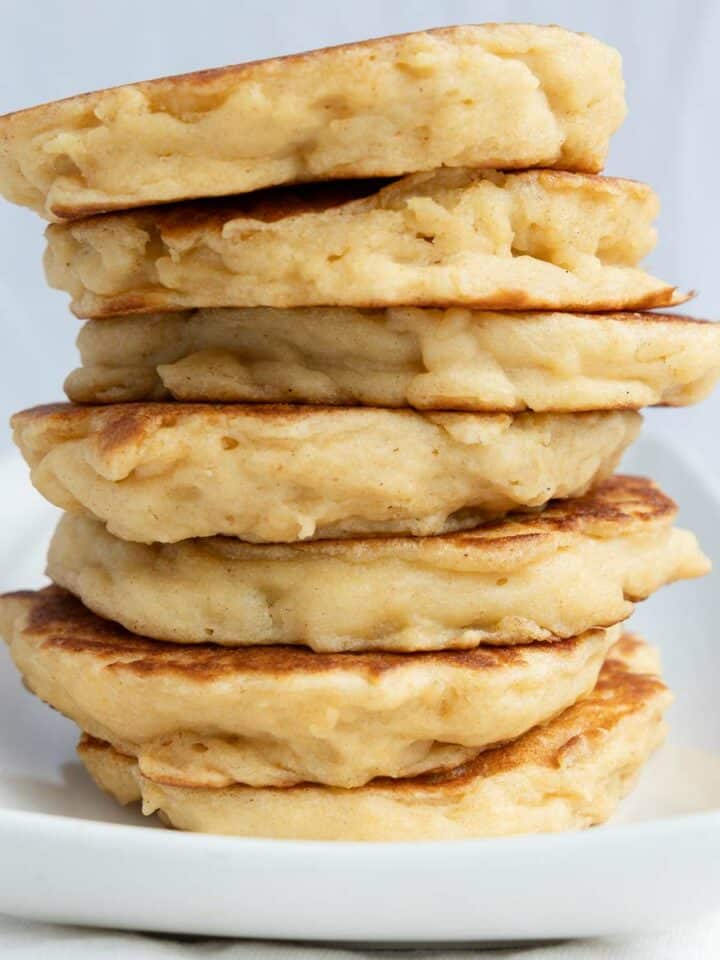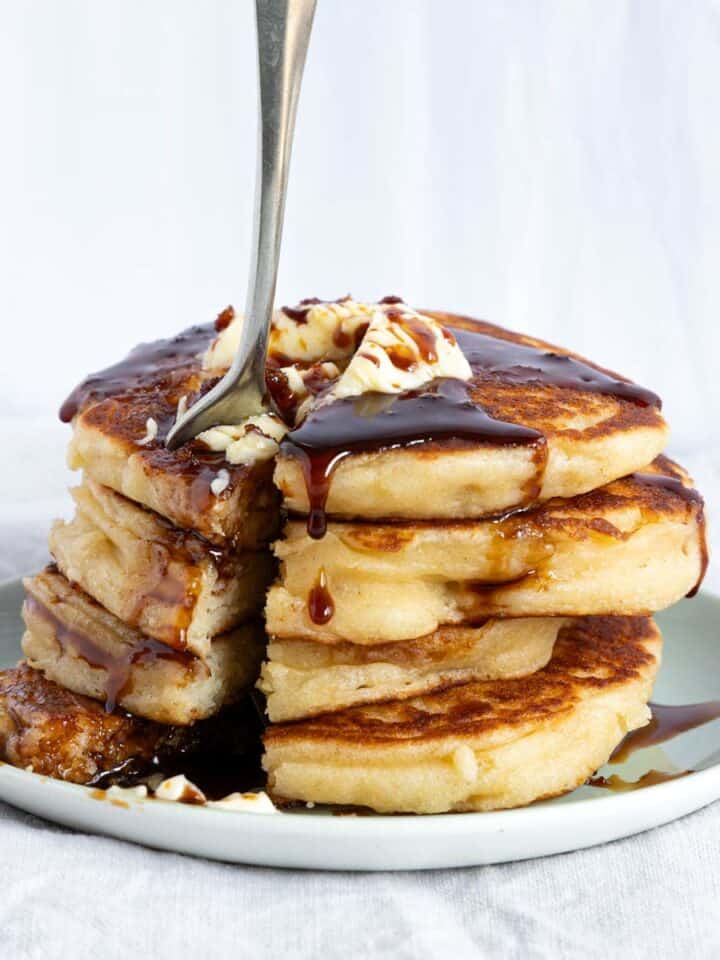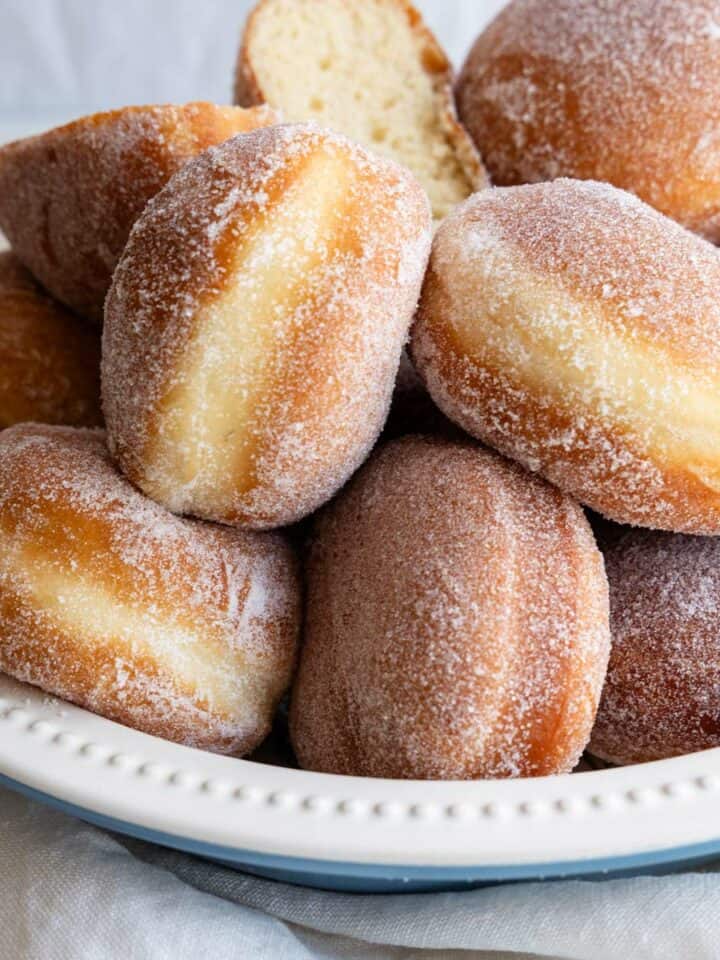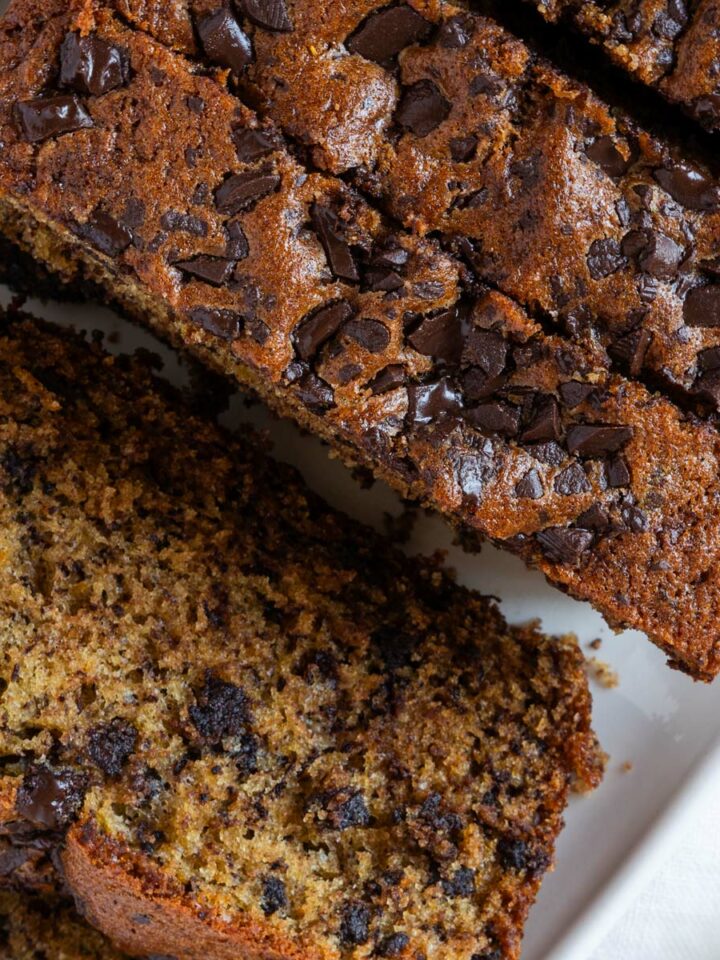
After lots of testing (and tasting), I have found the ideal ratio and method for a perfect foolproof scone recipe.
These traditional English scones are made from plain flour, no eggs and only take 12 minutes to bake.
⏳
40 - 45 minutes
👪
13 pcs
🍎
258 kcal/scone
Bookmarks
- Revised and Better
- 📃 Ingredients Comparison
- ❤️ Why I like My New Scone Recipe
- 🔍 Ingredients to use and why
- 💡 Tips on how to make the best English Scones
- 📷 How to Make Foolproof Scones - Step by Step
- How to Scale my Foolproof Scones
- How to Alter the Recipe
- How to eat English Scones
- Can Scones be Frozen and Reheated?
- My Foolproof Scones / New Improved Recipe
Revised and Better
It's been a few years since I set myself a goal to find the best recipe for traditional English scones.
On my scone journey, I've tested several recipes ranging from small food blogs to famous chefs including Paul Hollywood and Jamie Oliver with various results. Since I wasn't completely happy with any of the recipes I tested, I decided to make my own.
However happy I was with my own scone recipe back then - forward a couple of years, several more scone tests and recent experiments with James Martin's scones - I came to the conclusion that my list of ingredients was too long, making the recipe faff to make.
That's why I decided it's time for a few changes. Less is more and my scones are a good example of it.
📃 Ingredients Comparison
Old version
- 500 g plain flour
- 5 teaspoon baking powder
- ½ teaspoon bicarbonate of soda
- ½ teaspoon citric acid
- 80 g sugar (½ caster, ½ muscovado )
- 150 g chilled butter
- 2 eggs
- 160 ml milk
Updated recipe
- 500 g plain flour
- 5 teaspoon baking powder; levelled
- 75 g caster sugar
- 150 g butter, chilled and cut into small cubes
- 250 ml full-fat milk
Optional:
- pinch of salt
As you can see my new scone recipe contains fewer ingredients. I actually found that:
- The amount of flour in my old recipe doesn't need as much leavening agent nor did it need two different leaveners.
- Citric acid is not a very common ingredient and is easy to over-use it; once I removed bicarbonate of soda from the recipe it wasn't needed.
- The recipe doesn't require eggs; I've learnt that scones without eggs are more delicate and light, and they rise more upwards.
❤️ Why I like My New Scone Recipe
- contains fewer ingredients
- easy to make
- quick
- makes good looking scones with a good rise
- scones are light and fluffy
- the recipe is easy to scale or adjust to either sweet or savoury options

🔍 Ingredients to use and why
Can scones be made with plain flour?
The answer is yes; you can use plain flour for making scones as long as you add a sufficient amount of raising agent.
Alternatives:
- strong (bread) flour (contains more gluten)
I like plain flour the best but it can be replaced with strong flour.
Note: Strong flour can make the scones slightly chewier (possibly because it contains more gluten - something I learnt from testing Paul Hollywood’s recipe).

Should you put eggs in scones?
This question seems to divide scone fans into two camps. From what I’ve found, some authentic recipes don't contain eggs, but many chefs including Mary Berry, Paul Hollywood, Jamie Oliver or even the royal family pastry chef use them. Does it mean that eggs in the dough make better scones?
I couldn't leave this question unanswered, so I made two batches of scones with and without eggs:
- The scones with eggs tasted richer, they were less crumbly, and they had more of a chewiness to them, possibly because the egg binds ingredients together. These scones also spread more, rising in all directions.
- In comparison, scones without eggs were more delicate and felt softer with even upward rise; every bite melted in the mouth.
There is no right or wrong. You can put eggs into scone dough to make them taste fuller, but does the dough need the eggs? No, it certainly doesn't. It surprised me, but I have to confess that we enjoyed the scones without eggs better.

Baking powder vs Bicarbonate of Soda
Both are leavening agents used in baking.
Baking powder is a pre-mix of a few components (diphosphates/acidic compound, sodium carbonates and maize starch). It reacts in two phases. The first reaction happens once the baking powder is mixed with liquid and the second reaction goes off when it's exposed to heat.
The bicarbonate of soda is a single agent and needs to be used in combination with an acidic ingredient and liquid. Once the bicarbonate of soda, acid and liquid are combined, the reaction immediately produces carbon dioxide that helps the dough to rise.
Bicarbonate of soda on its own has a strong soapy, almost metallic flavour that needs to be “deactivated” by a sufficient amount of acidic sources - like buttermilk, lemon juice, apple sauce, cream of tartar, citric acid or even brown sugar.
Note: I was using both leaving agents in my original recipe, to achieve a taller rise. The baking powder gave the scones the main boost while the bicarbonate of soda and citric acid were there for a small extra push.
This updated recipe contains only baking powder as I realised that while the rise was great, combining the bicarbonate of soda with baking powder and citric acid can leave scones with an unpleasant aftertaste.
Going back to only one raising agent is a safer option.
💡 Tips on how to make the best English Scones
Should butter be cold for scones?
Small flakes of cold butter in the dough will help to make softer, more crumbly scones that will rise better.
It's not necessary to freeze the butter as some suggest. Using chilled butter from the fridge works just fine.
How much liquid to use?
Scone dough suppose to be a little bit sticky, but not too wet. I know it has the right consistency when it sticks to my fingers but leaves the edges of the bowl clean.
The recommended amount of milk is more of a guidance. It is because different flour absorbs different amounts of liquid. Most likely, you won't need all of it.
My advice is to add the milk in a few steps. At first, pour around ⅔ (a little over half of the milk) into the flour. Then keep adding the milk in smaller amounts to prevent making the dough too wet.
If you have a problem mixing all dry flour into the dough add another splash of milk, if the dough is too wet add more flour.
Does it help to work the dough as little as possible?
Based on my tests, working the dough less makes lighter scones. As it can be tricky to judge when it is the best time to stop I follow these steps:
- use your fingertips to rub the butter into the flour until it makes fine breadcrumb consistency
- gently incorporate milk into the dry ingredients with your hand until all the flour is mixed in
- tip the dough onto a floured surface and give it 5 - 6 gentle 'folds and turns'. Don't try to knead the dough like bread to create a smooth dough.
Should you rest scones before baking?
I tried to chill the dough in the fridge before cutting the scones out (following Jamie Oliver's recipe). However, I find it easier to cut out scones first, give them an egg wash and let them rest in the fridge already ready on a baking tray.
I can confirm that the rested scones rose better compared to the unrested dough. The difference was noticeable, but if you don't have a space in the fridge don't worry too much.
How thick to roll/pat the dough?
You can roll the dough into the desired thickness with a rolling pin or shape it by patting it with your hands. I use my hands, as I feel my dough is too messy for a rolling pin.
Tip: Don't pat the dough thinner than 2.5 - 3 centimetres if you wish to make nice tall scones.

How to make scones go brown on top? Can I use milk instead of egg wash?
To achieve a beautiful golden-brown top on your scones give them an egg wash before baking. You can use either whole egg or only egg yolk (makes the top more yellow).
An egg gives an excellent result, but if you don't want to use it, you can brush the top of the scones with these alternatives:
- milk or cream
- melted butter
- coconut oil (vegan)
- honey or maple syrup

Can you make scones without a cutter?
You can use any round object with thin walls (easier for cutting) like a can or small plastic container. I don't like using glass as it has thicker walls.
Small, empty and clean tin with a diameter of around 5 cm is a good replacement for a pastry cutter.
Alternatively, you don't need a cutter at all. Simply make American-style scones by shaping the dough into a round disk and cutting it into wedges.
Tips Overview
Scones are not difficult to make, but perfect looking scones can be more challenging. Follow these tips for the best result:
- weigh all ingredients using kitchen scales
- keep refrigerated ingredients cold
- use a sufficient amount of raising agent (for each 100g of plain flour use 1 levelled teaspoon of baking powder)
- don’t overmix/overhandle the dough
- let the cut-out scones rest in the fridge before baking
- don’t pat the dough too thin if you want tall scones
- use egg wash to achieve a beautiful brown top
📷 How to Make Foolproof Scones - Step by Step
Preheat the oven to 200 C/180 C fan and line the tray with baking paper.
Combine all dry ingredients: Sift the flour and mix it with the baking powder, sugar and salt.
Rub in the butter with your fingers until the mix resembles a fine breadcrumb.
Pour a little over half of the milk into the flour and with your hands gently combine the wet and dry ingredients. Keep adding the rest of the milk in small steps preventing the dough from becoming too wet and sticky.
Once the dry flour is incorporated into the dough stop adding more liquid; the dough will look lumpy and messy.
Note: Not all flour absorbs the same amount of liquid - you might not need all the milk.
Tip: The dough has the right consistency when it sticks to my fingers but leaves the edges of the bowl clean.
Transfer the dough onto a floured surface and dust with more flour over the top (dust your hands too if the dough is too sticky). Give it around 5 gentle 'folds and turns' to make it a little smoother.
With your hands shape the dough into a circular/oval disc approximately 2.5 - 3 centimetres thick.
Cut the scones out with a round pastry cutter - 5.5 cm for smaller scones (makes 13 pcs) or around 7 cm for bigger ones. Place the scones onto a baking tray lined with baking paper, leaving a small gap in between each.
Note: You can press together the leftover dough to be able to cut a few more scones out of it. The more you work with the dough tougher it gets, so I re-use the leftovers only once.
Brush the top of each scone with a beaten egg.
Tip: If you have time and space, rest the tray with cutout scones in the fridge for 15 minutes before baking.
Bake the scones at 200 C/180 C fan for 12 - 13 minutes or until they have risen and are golden brown.
How to Scale my Foolproof Scones
Do you need to scale the recipe to make a bigger or smaller batch? It's easy if you know the ingredients' ratios.
For every 100g of plain flour (the dough thickness 2.5 cm - using a 5.5 cm cutter - makes 2.5 scones) you need:
- 1 teaspoon of baking powder
- 15 grams of caster sugar
- 30 grams of butter
- 44 millilitres of milk
How to Alter the Recipe
It's super easy to change these plain scones into various sweet or savoury options.
For sweet scones - you can try to add different dry fruit, like a handful of raisins into the dough.
If you decide to pre-soak the raisins make sure you squeeze the liquid out before mixing the fruit into the dough and consider adding less milk.
For savoury scones - reduce the sugar and mix in 150 grams of grated cheddar cheese, you can also experiment with adding bacon, caramelised onion or different fresh herbs.
How to eat English Scones
The two much loved English customs linked to scones are Cream tea and Afternoon tea.
Cream tea is a name for a light snack consisting of a cup of tea and a scone.
Traditional Afternoon tea is a light meal served between lunch and dinner. It consists of a tier of sandwiches, mini cakes and a tier of scones.
The scones are served accompanied by clotted cream and jam for both occasions. You possibly heard about the famous disagreement of what topping goes first - the jam or the cream.
Try a little test to find out what your preference is. I like the Devonshire way - clotted cream first followed by a jam. If your preference is jam first topped with a spoon of clotted cream you like the Cornish method. To my surprise, the order of the toppings actually affects the final taste.
If you want to be authentic, don’t cut a scone with a knife, the correct way is to break the scone in half with your fingers.
Can Scones be Frozen and Reheated?
Scones always taste the best when they are freshly baked and still slightly warm. They quickly become dense and stale once they cool down.
If you don't eat all of the scones the same day, your best solution is to freeze them in an airtight ziplock bag while they are still fresh.
Defrost frozen scones at room temperature (20- 30 minutes) and heat them up for 10 seconds in the microwave or 4 minutes in the oven (160C) just before serving. Reheating them makes them soft again. They'll be almost as good as freshly baked scones.
My Foolproof Scones / New Improved Recipe
Ingredients
- 500 g plain flour alternative: strong flour
- 5 teaspoon baking powder each teaspoon leveled
- 75 g caster sugar
- 150 g butter chilled and cut to small cubes
- 250 ml full-fat milk
- 1 egg for egg-wash; chilled and beaten
Equipment
- large mixing bowl
- oven tray
- baking paper
- round pastry cutter 5.5 cm for smaller scones (makes 13 pcs)
Instructions
- Heat the oven to 200 C/180 C fan and line the tray with baking paper.
- Sift the flour and mix it with the baking powder, sugar and salt.
- Rub the butter with dry ingredients using your fingers until the mix resembles a fine breadcrumb.
- Pour a little over half of the milk into the flour and gently combine the wet and dry ingredients with your hands. Keep adding the rest of the milk in small steps preventing the dough from becoming too wet. Once the dry flour is all incorporated into the dough stop adding more liquid; the dough will look lumpy and messy.Note: Not all flour absorbs the same amount of liquid - you might not need all the milk. Tip: The dough has the right consistency when it sticks to my fingers, but the bowl's edges stay clean.
- Transfer the dough onto a floured surface and dust with more flour over the top. (Dust your hand too if the dough is very sticky).Give it around 5 gentle 'folds and turns' to make it a litte smoother.
- With your hands pat the dough into a circular/oval disc approximately 2.5 - 3 centimetres tall.
- Cut the scones out with a round pastry cutter - 5.5 cm for smaller scones (makes 13 pcs) or around 7 cm for bigger ones. Place the scones onto a baking tray lined with baking paper, leaving a small gap in between each.Note: You can press together the leftover dough to be able to cut a few more scones out of it. The more you work with the dough tougher it gets, so I re-use the dough only once.
- Brush the top of each scone with a beaten egg.
- Optional: If you have time and space, rest the tray with cutout scones in the fridge for 15 minutes before baking.
- Bake the scones at 200 C/180 C fan for 12 - 13 minutes or until they have risen and are golden brown.
Notes
- weigh all ingredients using kitchen scales
- keep refrigerated ingredients cold
- use a sufficient amount of raising agent (for each 100g of plain flour use 1 levelled teaspoon of baking powder)
- don’t overmix/overhandle the dough
- let the cut-out scones rest in the fridge before baking
- don’t pat the dough too thin if you want tall scones
- use egg wash to achieve a beautiful brown top


















Jean says
Fantastic - great advice and wonderful taste. Thank you
Vivian says
Tasty n delicious
Hilary says
Why not use grams for the extra raising agents? "Just under..." is hardly accurate and kitchen scales will read to 1gm accuracy.
Lea says
Hi Hilary, you are right. It would be more accurate to use metrics for the extra raising agent and citric acid. The only reason why I didn't include grams is that my kitchen scales don't weigh such a small amount (it is roughly around 1g). I guess it's a good reason to invest in better kitchen scales 😉 I'll find out and update the ingredients.
Beatrice says
Too much sugar. In fact no sugar should be used at all. Personal opinion of course. Scones taste great without it.
Lea says
Hi Beatrice, it's an interesting point. I know that British scones are at least lightly sweetened nowadays. It's completely fine to reduce the amount of sugar in my recipe or not to use any if that's what you prefer.
Michal says
Už se těším, až přiletíme do Anglie a tyto koláčky ochutnáme.
Lea says
Ráda vám je připravím, ať už tady v UK nebo v ČR. Hlavně se těším, že se uvidíme.
Aamir says
Hi, itching to try this but prefer fruit scones. What recipe did you use for fruit scones?
Lea says
Hi Aamir, I like Jamie Oliver's fruit scone recipe. It's the one from his website - Crumbliest scones. I wrote a review in my other post Paul Hollywood scones vs Jamie Oliver so you can have a look and see how they turned out for me.
Erik says
Is 250ml =1 cup?
I am fortunate to have a scale that has metric and imperial for the other ingredients.
I'm looking forward to trying your recipe here in Los Angeles.
Lea says
I checked a few conversion sites online, and according to them, the equivalent of 250 ml is 1.06 cups (1 cup is 237 ml). I'm not sure how much I can trust those sites, and I'm unable to check myself. Please, let us know how the recipe turns out after converting it to the US non-metric measurements.
I made these scones yesterday, and they were so yummy.
Kaile says
Can I freeze the cut out dough for later and then frozen dough into oven?
Lea says
Hi Kaile, I've never tried to freeze the dough and then bake the scones from frozen. I like the idea though. You could be serving freshly baked scones within 15 minutes. It's worth testing. Some online sources say it should be possible. Let me know if you try, please.
Forbes PERKINS says
Love this recipe. This explanation is so thorough and helpful. Thank you.
I had never made a scone till recently. Now, Ive tried so many scone recipes and many are delicious. I feel as though I ought to buy a ticket for London and try some Cream or High Teas in some posh hotels in order to determine what a true English scone is really supposed to taste like. I do like it when they are small, round, well risen and have a crack in their side. (here in the States my scones are mistaken for common biscuits until I let my ignorant friends know that they are "The Queens Scone".) To what exactly do you attribute that pretty little split? The resting in the fridge? Im undecided as to whether I prefer an English cream scone or an Irish buttermilk scone. Next experiment will be cream+buttermilk although I suppose that will require a bit of soda.
Lea says
Thank you for the sweet comment. I like the scones precisely as you do. I'd never tasted authentic English scones until I relocated to the UK, and these humble-looking guys surprised me. Even though they are so simple, they taste great. I like them the best served the traditional English way with clotted cream (possible to substitute with mascarpone cheese) and strawberry jam. They are a fantastic companion to English tea.
Good luck with your experiments.
PS: Even though I've tested many scone recipes, I can't tell for sure what makes the horizontal crack. It seems to be a combination of factors rather than just one single thing.
Linda says
Hello
Thank you so much for sharing your Recipe and for the thorough explaination.
I found myself here because I had just tasted Scones without eggs and they were soft and melt in your mouth and I was puzzled how it is possible to make such Scones without eggs.You have answered all of my scone questions,I cant wait to try your Recipe,I am convinced even before I have made it,that The Scones are Super yummy and amazing.Thank you❤